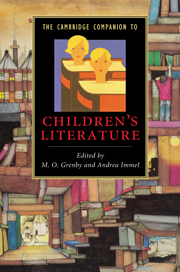Book contents
- Frontmatter
- Part I Contexts and Genres
- 1 The origins of children’s literature
- 2 Children’s books and constructions of childhood
- 3 The making of children’s books
- 4 Picture-book worlds and ways of seeing
- 5 The fear of poetry
- 6 Retelling stories across time and cultures
- 7 Classics and canons
- Part II Audiences
- Part III Forms and Themes
- Further reading
- Index
7 - Classics and canons
from Part I - Contexts and Genres
Published online by Cambridge University Press: 28 November 2010
- Frontmatter
- Part I Contexts and Genres
- 1 The origins of children’s literature
- 2 Children’s books and constructions of childhood
- 3 The making of children’s books
- 4 Picture-book worlds and ways of seeing
- 5 The fear of poetry
- 6 Retelling stories across time and cultures
- 7 Classics and canons
- Part II Audiences
- Part III Forms and Themes
- Further reading
- Index
Summary
Most readers of American and British children's literature can easily offer examples of children's literature classics, readily agreeing that, say, Lewis Carroll's Alice's Adventures in Wonderland (1865) would belong in that category. As its front-line representatives, classics publicly define the genre - but how does the genre define its classics? In order to answer this question, one must explore the unique forces and processes that affect children's literature and its reception. Children's literature operates differently from adult literature, for the latter offers a consistency of creators and audience: an adult book is written by adults, read by adults, judged by adults and passed on to adults; the people in the position of gatekeepers, selecting and championing particular texts for admission to the canon and lionisation as classics, are themselves inarguably members of those texts' official and intended audiences. The forces behind the approval and canonisation of children's literature constitute a complex Venn diagram, with categories defined by profession (academic literary critic or hands-on practitioner in libraries or schools), fields of study (English department, education department or school of library science), professional status (professional user of children's literature or lay reader of books as parent or interested adult) and age (child or adult), all in dynamic relationship to one another, with categories sometimes overlapping, sometimes acting complementarily, sometimes operating antagonistically.
- Type
- Chapter
- Information
- The Cambridge Companion to Children's Literature , pp. 108 - 124Publisher: Cambridge University PressPrint publication year: 2009
- 4
- Cited by

